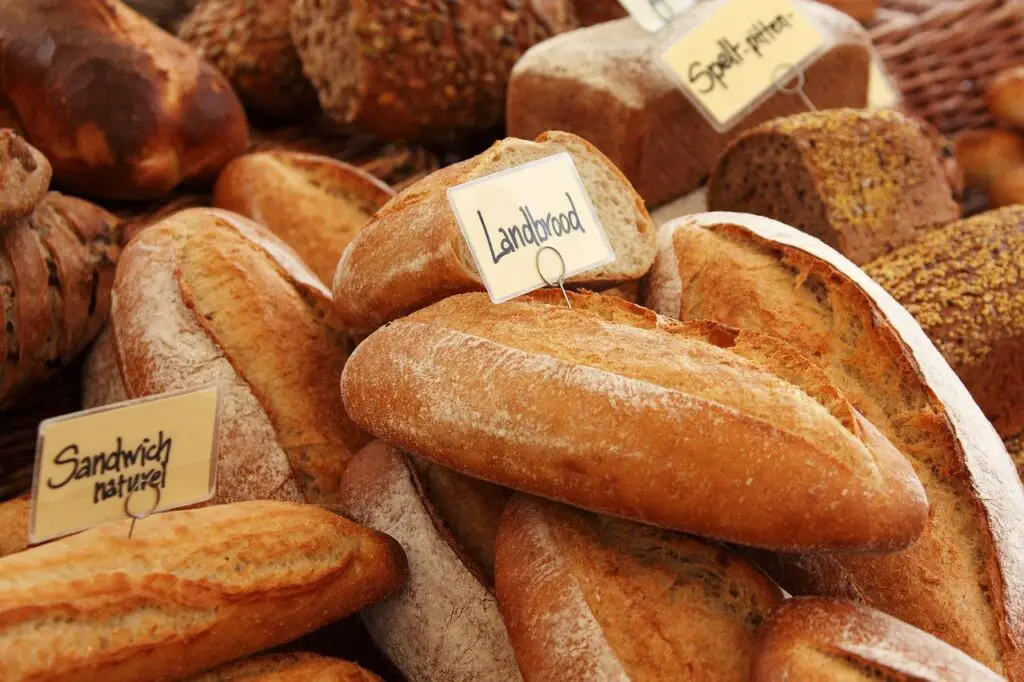Bread is a staple diet for most households, from the morning toast for breakfast to making sandwiches at lunchtime.
As such, your dog has become accustomed to the aroma of your favorite bread.
You are scared of sharing every time bread is served since you don’t know how well the dog will handle the bread crust.
Can dogs eat bread crust?
Yes, dogs can have small amounts of bread crust.
Keep it moderate to avoid having digestive issues due to the ingredients, such as gluten.
Too much of the bread crust could also be a recipe for an overweight dog.
This article explores the benefits of sharing the bread crust sparingly and the risks of overdoing it.
Read on to arm yourself better with information, and be prepared next time your canine friend expressively asks for the bread crust.

Benefits of Sharing Bread Crust with Your Dog
The small amounts of bread crust benefit your pooch in various ways.
Here’s how:
- Rich in Fiber
Bread crusts are rich in fiber, and having it in your dog’s meal has various benefits, some of which include:
- Aids in the absorption of excess water in the dog’s body
- Helps in the formation of firm stool
- It prevents the growth and spread of undesirable bacteria
- It helps the dog have a balanced intestinal PH
- Improves the health of your dog’s entire gut system
It’s therefore important to include regulated amounts of fiber in your dog’s meal, and the bread crust is a great source.
- Detoxifies the Dog’s System
The bread crust has proven to be a great antioxidant for humans and dogs.
This is because the crust carries the pronyl-lysine compound, which forms as the crust is formed during the baking process and is a strong antioxidant.
Antioxidants in dogs are imperative as they help prevent overall body inflammation, slow the aging process and improve the overall health of your canine friend.
By fighting free radicals and aiding in the formation of new cells, antioxidants found in the bread crust are key to improving the well-being of your dog.
- Energy Boost
Dogs use up a lot of energy, given that they are most active throughout the day.
The bread crust is a source of carbohydrates and, as such, helps strengthen the dog’s muscles and provides much-needed balance.
The carbs in the bread crust also help keep the dog full for longer, and as such, they prevent the dog from overfeeding.
They also improve the overall functioning of the metabolic system.
- Great Treat
Pet owners are known to relish offering treats to their dogs as a reward for good behavior.
What better way to show compassion than to share the bread crust as a snack treat?
The bread crust makes the most flavorful part of your bread, and sharing it with your canine friend will have your pooch feeling honored.

Potential Health Risks of Sharing Too Much Bread Crust with Your Dog
The bread crust is a wheat product and, as such, could pose health risks to your furry friend.
Some potential risks include:
- Allergic Reactions
The crust could lead to your dog having an allergic reaction.
The wheat and gluten found in the bread crust could be potential allergic triggers.
To know if your dog is allergic to the bread crust after sharing the crust for the first time, check out these signs:
- Itchiness, especially around the eyes and earflaps
- Irritability
- Vomiting
- Diarrhea
- Restlessness
- Swelling face
Allergic reactions in dogs are a bother and will affect the dog in different ways, including loss of appetite and poor health.
Dogs also lose their vibrance, joy and vigor during a reaction.
Consult the veterinarian if you observe some of these signs after sharing the bread crust.
- Weight Gain
Too much of the bread crust means increased carbohydrates and sugar intake for your dog.
Like in humans, excessive indulgence leads to weight gain.
Canine obesity is a major threat to a dog’s overall well-being.
This is because a dog’s metabolic system is slower when working on carbohydrates meaning their absorption and conversion into the system is also slow.
This interference with the digestive system and storage leads to additional weight.
Weight gain in dogs comes with its set of problems, including:
- Diabetes
- Hypertension
- Osteoarthritis
- Difficult in breathing
- Joints problems
It’s therefore important to steer clear or share sparingly foods that can lead to weight gain, such as the bread crust.
- Toxicity
Some of the ingredients found in the bread crust can be toxic for your dog.
For instance, using artificial sweeteners such as xylitol will make the bread crust toxic for your dog.
Bread crusts laced with nuts, garlic, raisins and other components though good for humans, can turn out toxic for your dog.
Before sharing the bread crust with your dog, it’s important to check out the ingredients that can be toxic for the dog.
Alternatively, choose to bake the bread at home if you plan on sharing it with your furry friend.
Frequently Asked Questions
Is bread crust safe for my puppy?
Yes, the bread crust is safe for your puppy as it has high nutritional value that includes the antioxidants and carbohydrates necessary to keep your pup energized and healthy.
Puppies are playful and require enough energy to keep them vibrant and the bread crust is a good treat for them.
Can bread crust cause choking in dogs?
Yes, unfortunately for some dogs, the bread crust can cause choking.
This is because it may turn out difficult for them to chew.
To avoid getting to the ER due to choking, share the bread crust in small sizes and don’t leave the site until the dog is done with the crust treat.
That way, you will be able to respond fast in case of an emergency.
Bread crust should only be shared with your dog as an occasional treat at most twice a month.
At no point should the bread crust replace your dog’s regular meals.
Even during the occasional treat, share the crust in moderation to avoid the consequences of too many carbohydrates for your dog.
Conclusion
Bread crusts offer a great treat for your furry friend when shared in moderation and as long as the dog is not allergic.
Sharing an occasional treat will improve the relationship between the dog and yourself.
Such moments when the dog is over the moon due to a treat are savored.
Enjoy.
- What Dog Breeds Have Pink Skin? - March 24, 2023
- What Are the Most Inspiring Dog Breeding Quotes? - March 20, 2023
- Can Pheromone Spray Help Improve Dog Breeding Results? - March 19, 2023








